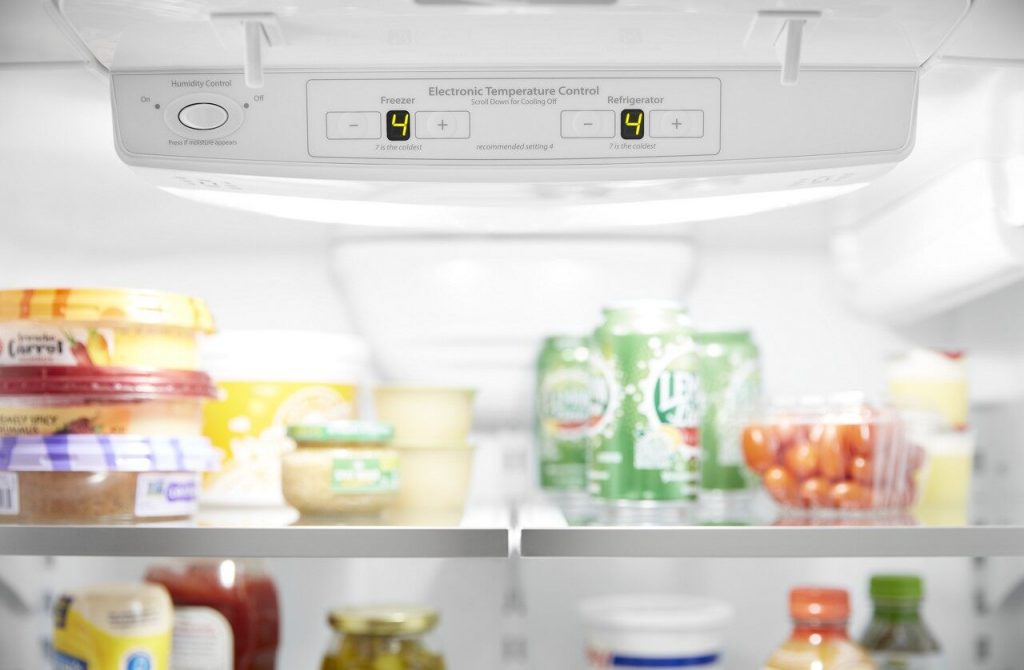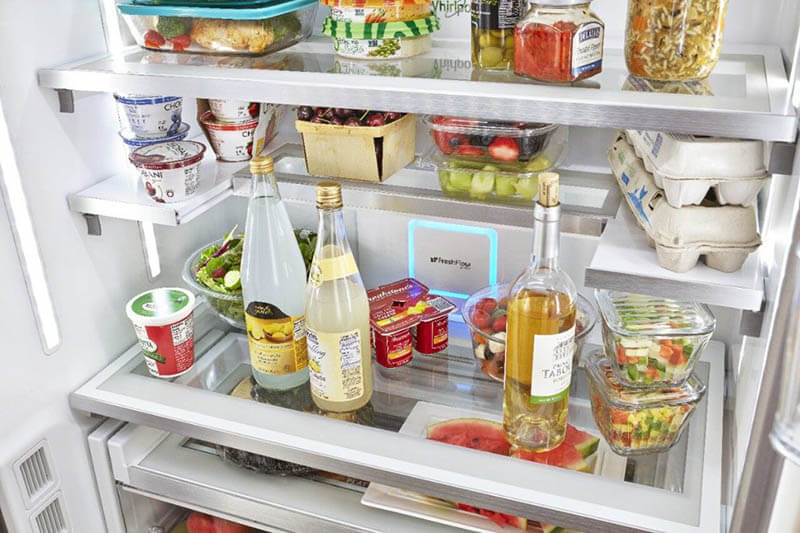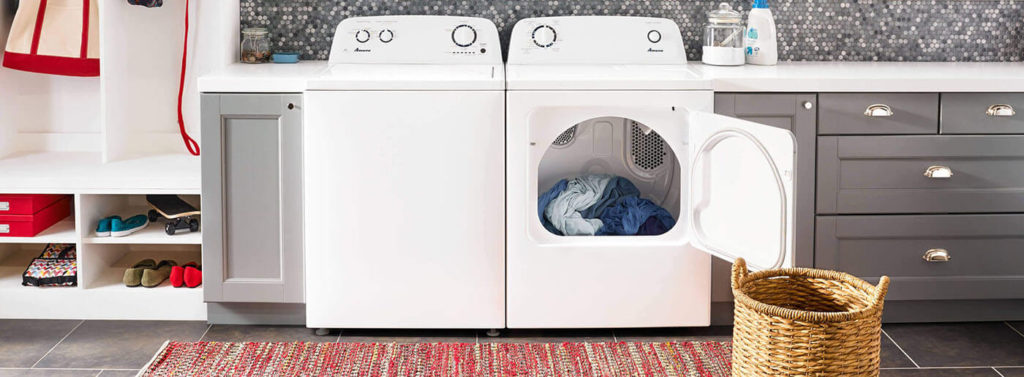Full-sized kitchen refrigerators typically have two compartments: the fridge and the freezer. Where the freezer is there to keep your items ice-cold, ideally -18°C (or 0°F) or below, the fridge compartment should never freeze your food. A refrigerator freezing food isn’t normal.
In this article, we’re going to help you understand why this is happening and help you solve this frustrating problem.
Table of Contents
Why It Happens and What You Can Do
Let’s get one thing out of the way. The fridge is made for keeping your food cold enough to preserve it, but not for as long as the freezer. Be that as it may, your refrigerator shouldn’t freeze anything. If you find frozen food inside your fridge – or worse, if your food actually develops freezer burn in the fridge – it’s a problem that needs fixing.
The first step to solving this issue is to understand why it occurs. It just so happens that there’s a slew of reasons why food may freeze in refrigerator environments.
Temperature Settings
One of the most benign causes of food freezing inside your refrigerator is a temperature setting that’s off. Your refrigerator has adjustable temperature controls for the freezer and the fridge.
The optimal temperature for fresh food storage inside a refrigerator is around 3°C (37°F) although a range of 0 – 4°C (33°F and 40°F) is generally accepted as safe for most purposes. So, a few degrees lower and you’re closing in on the freezing temperature of 0°C (32°F).

To address freezing in your refrigerator, try resetting your refrigerator’s thermostat temperature control. Adjust the temperature control to the temperature range indicated above. Consult your user guide for recommended temperature settings. Please note that many of today’s newer electronically controlled refrigerators are more likely to come with thermometer capabilities (displaying the actual temperature within your refrigerator). However if your refrigerator does not have a temperature display, you will need a thermometer to aid you in setting your refrigerator temperature.
Faulty Thermostat
In some instances, the mark on the thermostat adjustment knob may have faded. In this case, you might think that you’ve set the temperature lower than you might’ve thought.
Fortunately, this is not a big problem. Take a good look at it. If it’s completely erased, turn it down completely. Then, mark it on the first gradient with a permanent marker.
Sometimes the problem with the thermostat is not as simple as drawing back an erased line. In normal operation, the thermostat maintains a stable temperature by turning on and off. The problem arises when the thermostat fails to sense that the refrigerator has reached its set temperature and fails to turn off the cooling function. This leads to lower refrigerator temperatures, which can easily lead to items freezing inside.
Consult the fridge’s user manual and restart the thermostat. If this doesn’t solve the problem, you are best off referring to a refrigerator repair centre. You could go online and learn how to replace the thermostat yourself. However, if you don’t have enough experience, you’re best off leaving it to the professionals, such as The Appliance Pros.
Faulty Damper
A fridge-freezer combo unit makes use of the freezer compartment to cool the fridge compartment. The damper is a built-in device tasked with regulating the amount of air flowing from the freezer compartment into the fresh food compartment. If the damper malfunctions, it can fail to control the amount of freezer air entering the fresh food compartment and can lead to your food freezing.
Faulty dampers, like faulty thermostats, aren’t something that you should try fixing on your own.
If you have a Whirlpool®, Maytag®, Amana®, KitchenAid® or JennAir® fridge, and the service looks inevitable, the key is to put it in the hands of reliable and reputable experts, like The Appliance Pros.
Food Storage
Of course, the more items you put inside a fridge, the more obstructed the airflow may get. This is especially a problem if you have something blocking the air vents, leaving that stuff more exposed to cold air which may lead to food freezing.
On the other hand, a relatively empty refrigerator may also cause the food to freeze. Without enough things in the fridge, the cold air settles on the bottom, and may cause food there to freeze. The more food you have inside the fridge, the better the cold air absorption.

Therefore, achieving a good balance of too many and too few things in the fridge, without blocking the vents, will help prevent food from freezing in the fridge.
Even if there are too many items inside your refrigerator, there’s usually something that you can do to rearrange them. Try our guide for helpful tips to organize your fridge properly first, but if it’s really packed – you may have to buy less or upgrade to a larger refrigerator.
Leaky Seals
The gasket or seal is the lining on the inside of your fridge door that seals off heat exchange between the inside of the refrigerator and the environment. You may think that leaking cold air will only make the fridge less cool. This is a common misconception. The fact is that this will cause the fridge to work harder to maintain the temperature. It’s possible for the appliance to work so hard that it turns into a freezer, especially for those items that are closest to the air vents.
Fortunately, fridge door seals are replaceable. Before you browse for new seals, make sure that you clean the old ones properly. A thorough cleaning may resolve any leaking concern. However, if the seals are torn or warped, you will need a replacement. Get on it and you can solve this problem and save energy (therefore saving money on electricity too).
Replacing leaky seals isn’t too complicated and doesn’t necessarily warrant calling the professionals. Still, if you aren’t sure of what you’re doing, it’s always better to be safe than sorry. With that said, you can definitely try to clean the seals by yourself first.
Dirty Coils
On the outside of your refrigerator (either on the back or bottom behind your toe plate), you will see refrigerator coils (usually black in color). These are referred to as condenser coils. On the inside (typically not visible), you’ll find the evaporator coils. These coils work together to facilitate heat exchange between the refrigerant and the surroundings. Simply put, these two coils work together to move warm air out of your refrigerator.
Over time it is not unusual for your external (condenser) coils could get covered in dust or pet hair. A dirty condenser coil will cause your refrigerator to work harder and run less efficiently. Dirty coils have been known to cause inconsistent temperatures within a refrigerator. The solution is simple: just turn off the refrigerator and give the condenser coils a good cleaning. Your user guide may be a source to assist you with locating and cleaning your condenser coils.
Refrigerator Freezes
As you can see, there are a number of potential causes for a freezing refrigerator. It can even turn out to be quite complicated, the solution of which could be beyond adjusting the temperature control. Check your user’s manual for more troubleshooting tips. Unless it’s something simple, you might be better off having the fridge serviced than trying to fix it on your own.






